Comprehensive Analysis of the Travel and Tourism Sector: TUI Group
VerifiedAdded on 2020/07/22
|12
|3590
|64
Report
AI Summary
This report provides a comprehensive analysis of the travel and tourism sector, with a specific focus on the TUI Group. The introduction highlights the sector's contribution to GDP and outlines the report's scope, including the global environment, historical evolution, external factors, and policy impacts. Task 1 explores the structure of the travel and tourism sector, detailing key components such as transportation, accommodation, travel agents, tour operators, and attractions. Task 2 examines the implications of political changes on the sector, using examples from Spain and the UK. Task 3 delves into factors affecting tourism demand, including consumer income, price, quality, product appropriateness, innovations, currency restrictions, political relations, and climate. It also discusses supply-side adjustments to meet demand changes. Finally, the report assesses the positive and negative economic, environmental, and social impacts of tourism, and explores strategies to mitigate negative effects, referencing TUI Group's practices and sustainable development.
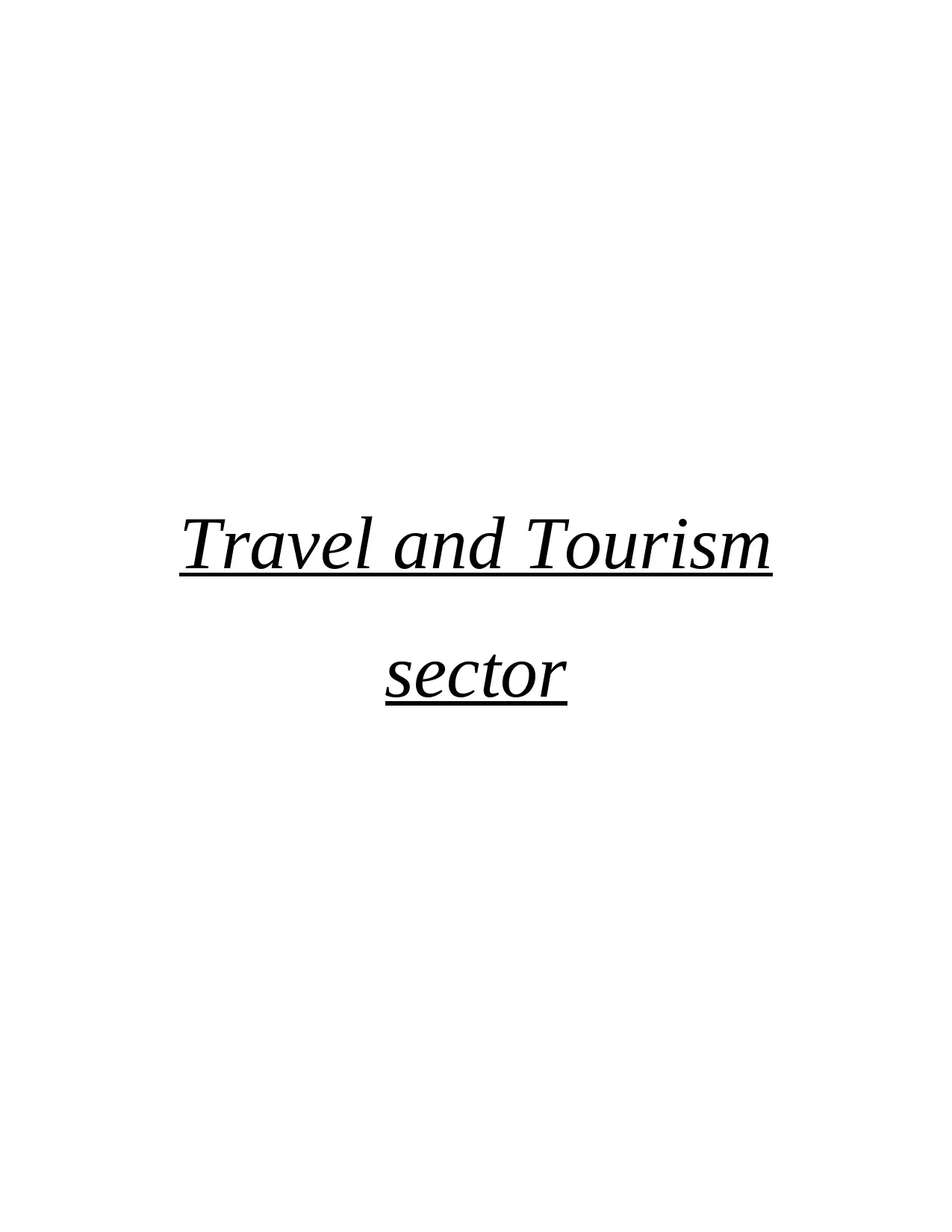
Travel and Tourism
sector
sector
Paraphrase This Document
Need a fresh take? Get an instant paraphrase of this document with our AI Paraphraser
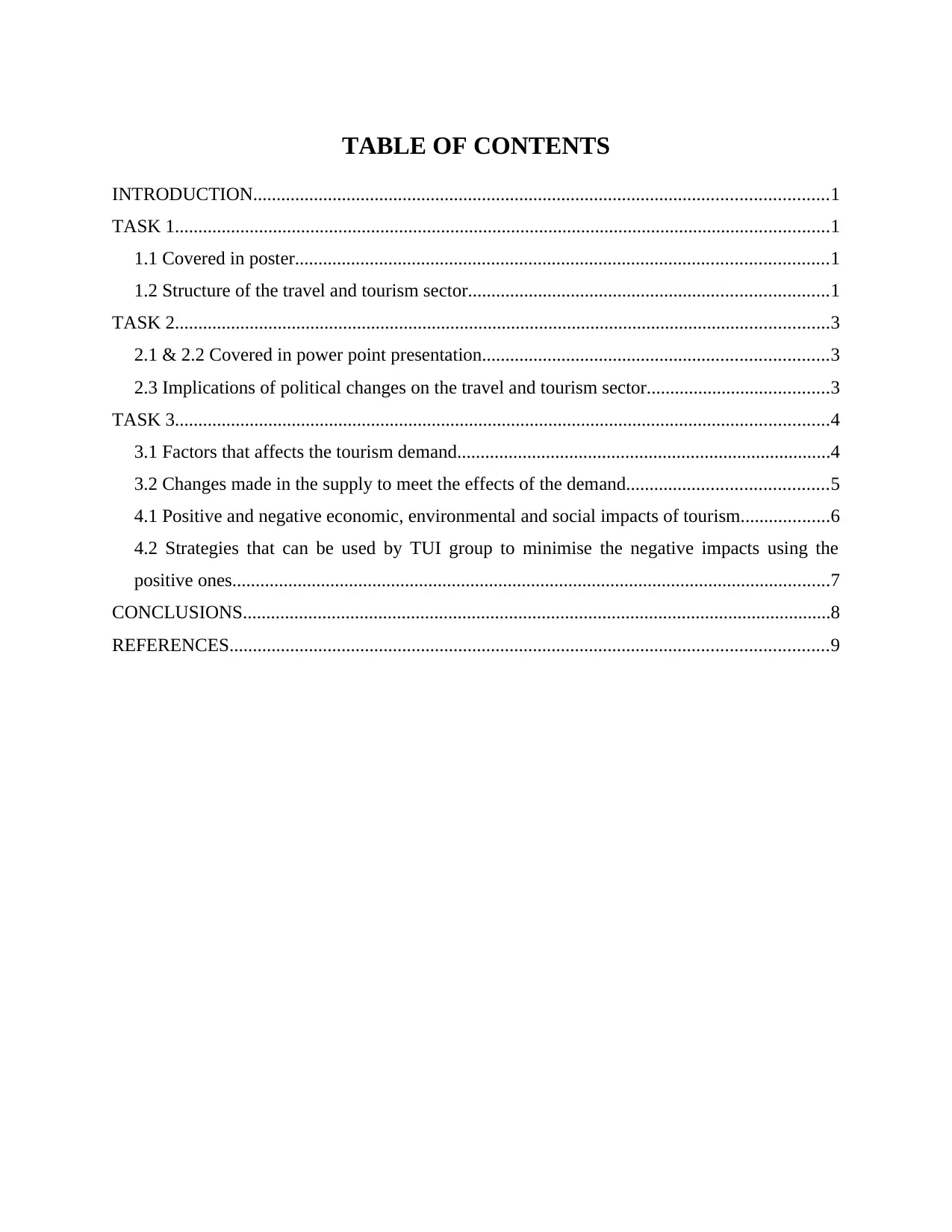
TABLE OF CONTENTS
INTRODUCTION...........................................................................................................................1
TASK 1............................................................................................................................................1
1.1 Covered in poster..................................................................................................................1
1.2 Structure of the travel and tourism sector.............................................................................1
TASK 2............................................................................................................................................3
2.1 & 2.2 Covered in power point presentation..........................................................................3
2.3 Implications of political changes on the travel and tourism sector.......................................3
TASK 3............................................................................................................................................4
3.1 Factors that affects the tourism demand................................................................................4
3.2 Changes made in the supply to meet the effects of the demand...........................................5
4.1 Positive and negative economic, environmental and social impacts of tourism...................6
4.2 Strategies that can be used by TUI group to minimise the negative impacts using the
positive ones................................................................................................................................7
CONCLUSIONS..............................................................................................................................8
REFERENCES................................................................................................................................9
INTRODUCTION...........................................................................................................................1
TASK 1............................................................................................................................................1
1.1 Covered in poster..................................................................................................................1
1.2 Structure of the travel and tourism sector.............................................................................1
TASK 2............................................................................................................................................3
2.1 & 2.2 Covered in power point presentation..........................................................................3
2.3 Implications of political changes on the travel and tourism sector.......................................3
TASK 3............................................................................................................................................4
3.1 Factors that affects the tourism demand................................................................................4
3.2 Changes made in the supply to meet the effects of the demand...........................................5
4.1 Positive and negative economic, environmental and social impacts of tourism...................6
4.2 Strategies that can be used by TUI group to minimise the negative impacts using the
positive ones................................................................................................................................7
CONCLUSIONS..............................................................................................................................8
REFERENCES................................................................................................................................9
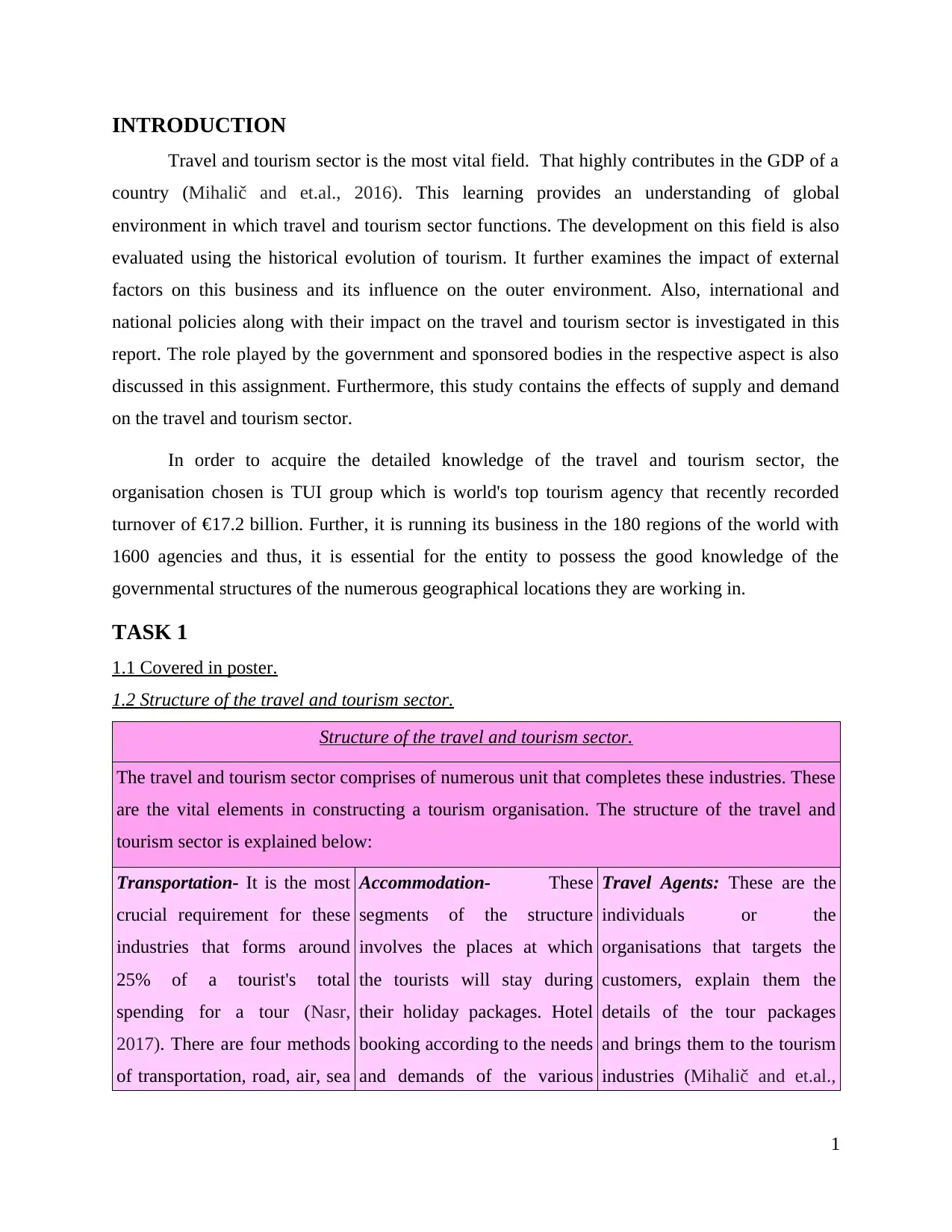
INTRODUCTION
Travel and tourism sector is the most vital field. That highly contributes in the GDP of a
country (Mihalič and et.al., 2016). This learning provides an understanding of global
environment in which travel and tourism sector functions. The development on this field is also
evaluated using the historical evolution of tourism. It further examines the impact of external
factors on this business and its influence on the outer environment. Also, international and
national policies along with their impact on the travel and tourism sector is investigated in this
report. The role played by the government and sponsored bodies in the respective aspect is also
discussed in this assignment. Furthermore, this study contains the effects of supply and demand
on the travel and tourism sector.
In order to acquire the detailed knowledge of the travel and tourism sector, the
organisation chosen is TUI group which is world's top tourism agency that recently recorded
turnover of €17.2 billion. Further, it is running its business in the 180 regions of the world with
1600 agencies and thus, it is essential for the entity to possess the good knowledge of the
governmental structures of the numerous geographical locations they are working in.
TASK 1
1.1 Covered in poster.
1.2 Structure of the travel and tourism sector.
Structure of the travel and tourism sector.
The travel and tourism sector comprises of numerous unit that completes these industries. These
are the vital elements in constructing a tourism organisation. The structure of the travel and
tourism sector is explained below:
Transportation- It is the most
crucial requirement for these
industries that forms around
25% of a tourist's total
spending for a tour (Nasr,
2017). There are four methods
of transportation, road, air, sea
Accommodation- These
segments of the structure
involves the places at which
the tourists will stay during
their holiday packages. Hotel
booking according to the needs
and demands of the various
Travel Agents: These are the
individuals or the
organisations that targets the
customers, explain them the
details of the tour packages
and brings them to the tourism
industries (Mihalič and et.al.,
1
Travel and tourism sector is the most vital field. That highly contributes in the GDP of a
country (Mihalič and et.al., 2016). This learning provides an understanding of global
environment in which travel and tourism sector functions. The development on this field is also
evaluated using the historical evolution of tourism. It further examines the impact of external
factors on this business and its influence on the outer environment. Also, international and
national policies along with their impact on the travel and tourism sector is investigated in this
report. The role played by the government and sponsored bodies in the respective aspect is also
discussed in this assignment. Furthermore, this study contains the effects of supply and demand
on the travel and tourism sector.
In order to acquire the detailed knowledge of the travel and tourism sector, the
organisation chosen is TUI group which is world's top tourism agency that recently recorded
turnover of €17.2 billion. Further, it is running its business in the 180 regions of the world with
1600 agencies and thus, it is essential for the entity to possess the good knowledge of the
governmental structures of the numerous geographical locations they are working in.
TASK 1
1.1 Covered in poster.
1.2 Structure of the travel and tourism sector.
Structure of the travel and tourism sector.
The travel and tourism sector comprises of numerous unit that completes these industries. These
are the vital elements in constructing a tourism organisation. The structure of the travel and
tourism sector is explained below:
Transportation- It is the most
crucial requirement for these
industries that forms around
25% of a tourist's total
spending for a tour (Nasr,
2017). There are four methods
of transportation, road, air, sea
Accommodation- These
segments of the structure
involves the places at which
the tourists will stay during
their holiday packages. Hotel
booking according to the needs
and demands of the various
Travel Agents: These are the
individuals or the
organisations that targets the
customers, explain them the
details of the tour packages
and brings them to the tourism
industries (Mihalič and et.al.,
1
⊘ This is a preview!⊘
Do you want full access?
Subscribe today to unlock all pages.

Trusted by 1+ million students worldwide
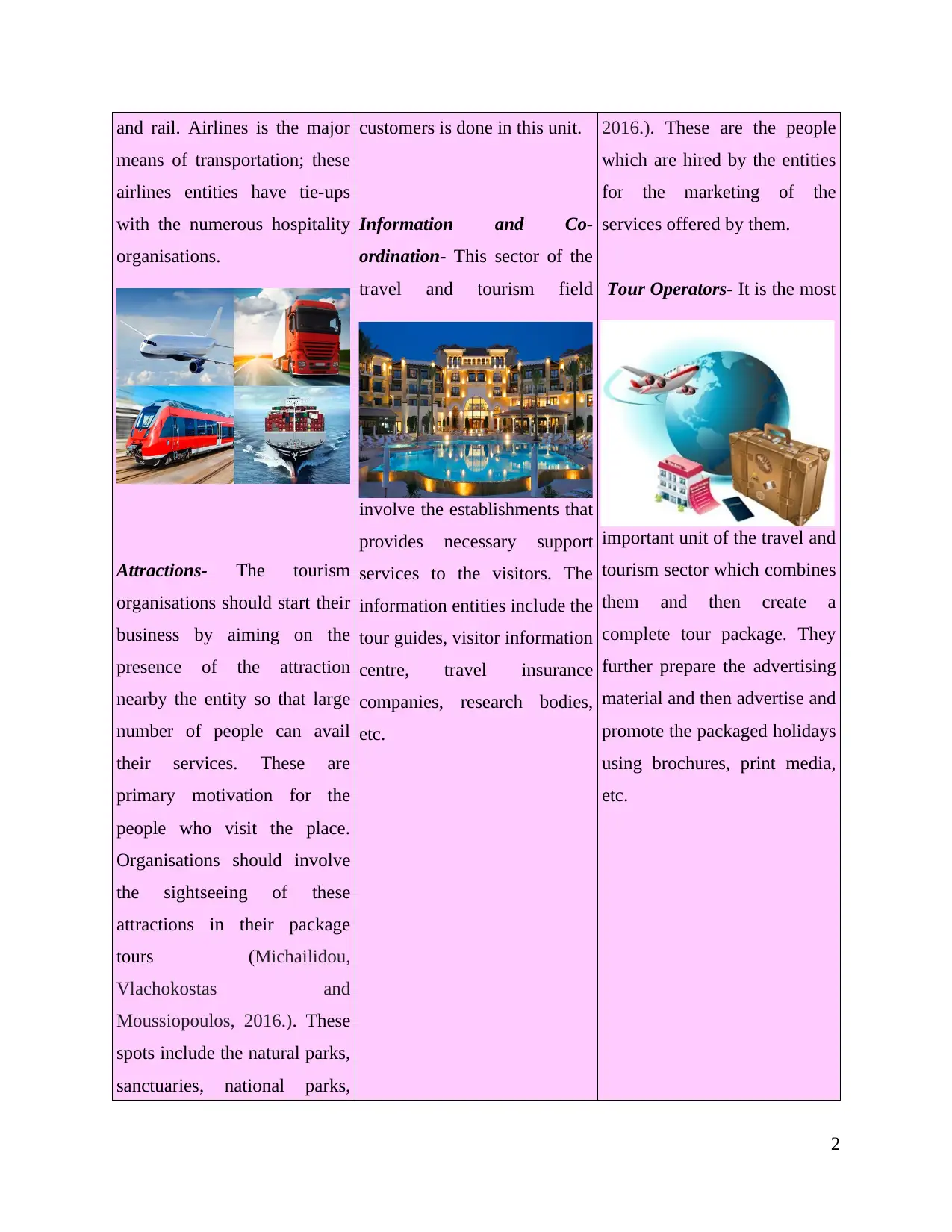
and rail. Airlines is the major
means of transportation; these
airlines entities have tie-ups
with the numerous hospitality
organisations.
Attractions- The tourism
organisations should start their
business by aiming on the
presence of the attraction
nearby the entity so that large
number of people can avail
their services. These are
primary motivation for the
people who visit the place.
Organisations should involve
the sightseeing of these
attractions in their package
tours (Michailidou,
Vlachokostas and
Moussiopoulos, 2016.). These
spots include the natural parks,
sanctuaries, national parks,
customers is done in this unit.
Information and Co-
ordination- This sector of the
travel and tourism field
involve the establishments that
provides necessary support
services to the visitors. The
information entities include the
tour guides, visitor information
centre, travel insurance
companies, research bodies,
etc.
2016.). These are the people
which are hired by the entities
for the marketing of the
services offered by them.
Tour Operators- It is the most
important unit of the travel and
tourism sector which combines
them and then create a
complete tour package. They
further prepare the advertising
material and then advertise and
promote the packaged holidays
using brochures, print media,
etc.
2
means of transportation; these
airlines entities have tie-ups
with the numerous hospitality
organisations.
Attractions- The tourism
organisations should start their
business by aiming on the
presence of the attraction
nearby the entity so that large
number of people can avail
their services. These are
primary motivation for the
people who visit the place.
Organisations should involve
the sightseeing of these
attractions in their package
tours (Michailidou,
Vlachokostas and
Moussiopoulos, 2016.). These
spots include the natural parks,
sanctuaries, national parks,
customers is done in this unit.
Information and Co-
ordination- This sector of the
travel and tourism field
involve the establishments that
provides necessary support
services to the visitors. The
information entities include the
tour guides, visitor information
centre, travel insurance
companies, research bodies,
etc.
2016.). These are the people
which are hired by the entities
for the marketing of the
services offered by them.
Tour Operators- It is the most
important unit of the travel and
tourism sector which combines
them and then create a
complete tour package. They
further prepare the advertising
material and then advertise and
promote the packaged holidays
using brochures, print media,
etc.
2
Paraphrase This Document
Need a fresh take? Get an instant paraphrase of this document with our AI Paraphraser
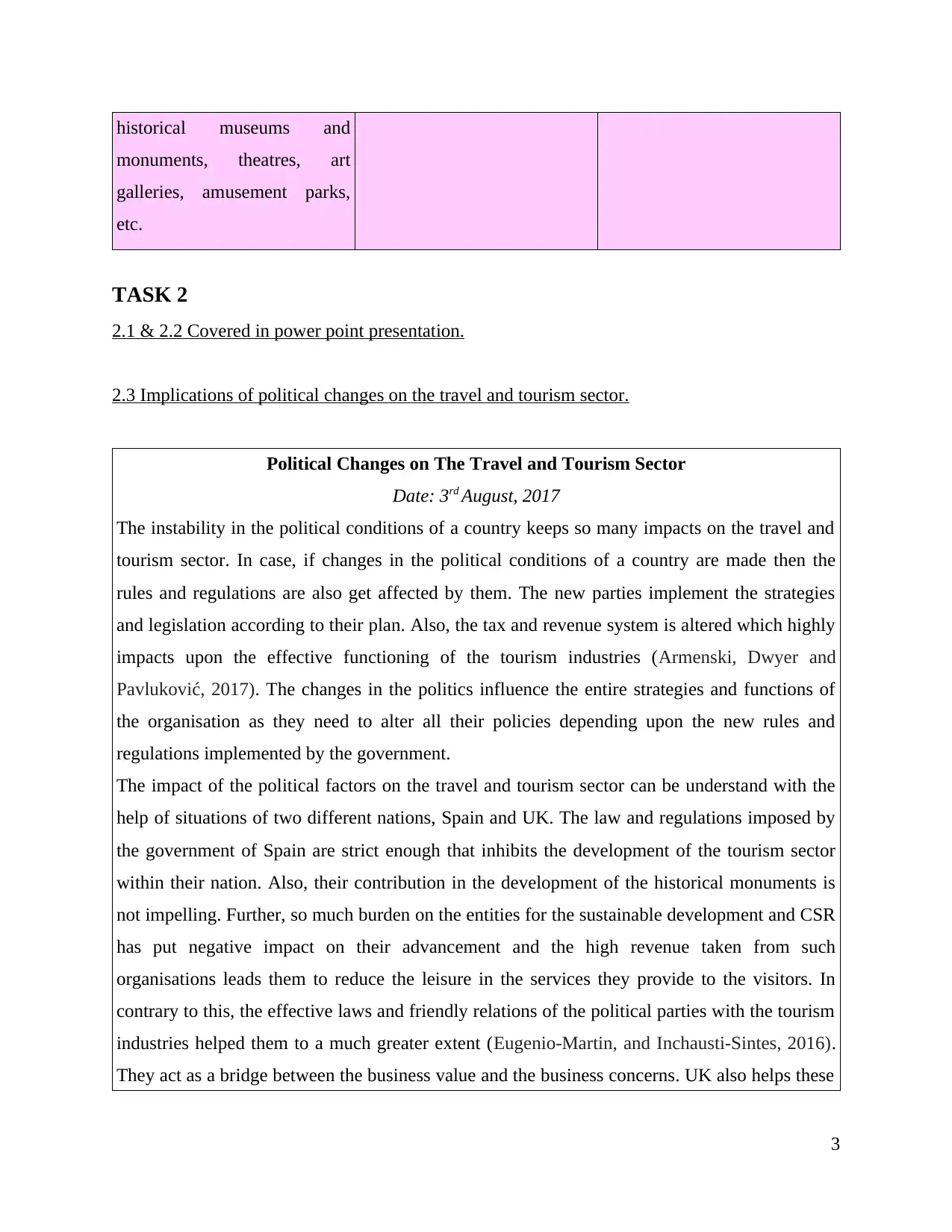
historical museums and
monuments, theatres, art
galleries, amusement parks,
etc.
TASK 2
2.1 & 2.2 Covered in power point presentation.
2.3 Implications of political changes on the travel and tourism sector.
Political Changes on The Travel and Tourism Sector
Date: 3rd August, 2017
The instability in the political conditions of a country keeps so many impacts on the travel and
tourism sector. In case, if changes in the political conditions of a country are made then the
rules and regulations are also get affected by them. The new parties implement the strategies
and legislation according to their plan. Also, the tax and revenue system is altered which highly
impacts upon the effective functioning of the tourism industries (Armenski, Dwyer and
Pavluković, 2017). The changes in the politics influence the entire strategies and functions of
the organisation as they need to alter all their policies depending upon the new rules and
regulations implemented by the government.
The impact of the political factors on the travel and tourism sector can be understand with the
help of situations of two different nations, Spain and UK. The law and regulations imposed by
the government of Spain are strict enough that inhibits the development of the tourism sector
within their nation. Also, their contribution in the development of the historical monuments is
not impelling. Further, so much burden on the entities for the sustainable development and CSR
has put negative impact on their advancement and the high revenue taken from such
organisations leads them to reduce the leisure in the services they provide to the visitors. In
contrary to this, the effective laws and friendly relations of the political parties with the tourism
industries helped them to a much greater extent (Eugenio-Martin, and Inchausti-Sintes, 2016).
They act as a bridge between the business value and the business concerns. UK also helps these
3
monuments, theatres, art
galleries, amusement parks,
etc.
TASK 2
2.1 & 2.2 Covered in power point presentation.
2.3 Implications of political changes on the travel and tourism sector.
Political Changes on The Travel and Tourism Sector
Date: 3rd August, 2017
The instability in the political conditions of a country keeps so many impacts on the travel and
tourism sector. In case, if changes in the political conditions of a country are made then the
rules and regulations are also get affected by them. The new parties implement the strategies
and legislation according to their plan. Also, the tax and revenue system is altered which highly
impacts upon the effective functioning of the tourism industries (Armenski, Dwyer and
Pavluković, 2017). The changes in the politics influence the entire strategies and functions of
the organisation as they need to alter all their policies depending upon the new rules and
regulations implemented by the government.
The impact of the political factors on the travel and tourism sector can be understand with the
help of situations of two different nations, Spain and UK. The law and regulations imposed by
the government of Spain are strict enough that inhibits the development of the tourism sector
within their nation. Also, their contribution in the development of the historical monuments is
not impelling. Further, so much burden on the entities for the sustainable development and CSR
has put negative impact on their advancement and the high revenue taken from such
organisations leads them to reduce the leisure in the services they provide to the visitors. In
contrary to this, the effective laws and friendly relations of the political parties with the tourism
industries helped them to a much greater extent (Eugenio-Martin, and Inchausti-Sintes, 2016).
They act as a bridge between the business value and the business concerns. UK also helps these
3
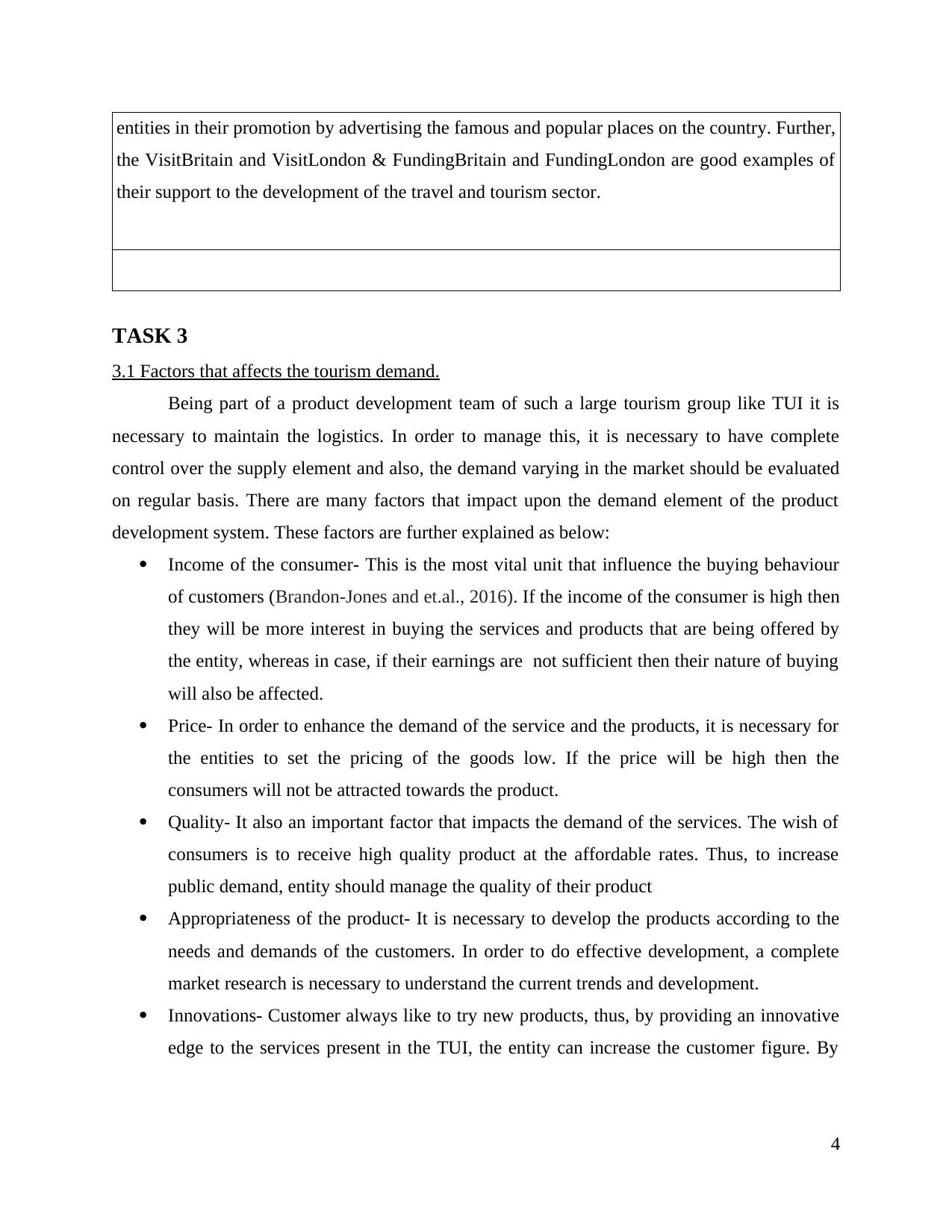
entities in their promotion by advertising the famous and popular places on the country. Further,
the VisitBritain and VisitLondon & FundingBritain and FundingLondon are good examples of
their support to the development of the travel and tourism sector.
TASK 3
3.1 Factors that affects the tourism demand.
Being part of a product development team of such a large tourism group like TUI it is
necessary to maintain the logistics. In order to manage this, it is necessary to have complete
control over the supply element and also, the demand varying in the market should be evaluated
on regular basis. There are many factors that impact upon the demand element of the product
development system. These factors are further explained as below:
Income of the consumer- This is the most vital unit that influence the buying behaviour
of customers (Brandon-Jones and et.al., 2016). If the income of the consumer is high then
they will be more interest in buying the services and products that are being offered by
the entity, whereas in case, if their earnings are not sufficient then their nature of buying
will also be affected.
Price- In order to enhance the demand of the service and the products, it is necessary for
the entities to set the pricing of the goods low. If the price will be high then the
consumers will not be attracted towards the product.
Quality- It also an important factor that impacts the demand of the services. The wish of
consumers is to receive high quality product at the affordable rates. Thus, to increase
public demand, entity should manage the quality of their product
Appropriateness of the product- It is necessary to develop the products according to the
needs and demands of the customers. In order to do effective development, a complete
market research is necessary to understand the current trends and development.
Innovations- Customer always like to try new products, thus, by providing an innovative
edge to the services present in the TUI, the entity can increase the customer figure. By
4
the VisitBritain and VisitLondon & FundingBritain and FundingLondon are good examples of
their support to the development of the travel and tourism sector.
TASK 3
3.1 Factors that affects the tourism demand.
Being part of a product development team of such a large tourism group like TUI it is
necessary to maintain the logistics. In order to manage this, it is necessary to have complete
control over the supply element and also, the demand varying in the market should be evaluated
on regular basis. There are many factors that impact upon the demand element of the product
development system. These factors are further explained as below:
Income of the consumer- This is the most vital unit that influence the buying behaviour
of customers (Brandon-Jones and et.al., 2016). If the income of the consumer is high then
they will be more interest in buying the services and products that are being offered by
the entity, whereas in case, if their earnings are not sufficient then their nature of buying
will also be affected.
Price- In order to enhance the demand of the service and the products, it is necessary for
the entities to set the pricing of the goods low. If the price will be high then the
consumers will not be attracted towards the product.
Quality- It also an important factor that impacts the demand of the services. The wish of
consumers is to receive high quality product at the affordable rates. Thus, to increase
public demand, entity should manage the quality of their product
Appropriateness of the product- It is necessary to develop the products according to the
needs and demands of the customers. In order to do effective development, a complete
market research is necessary to understand the current trends and development.
Innovations- Customer always like to try new products, thus, by providing an innovative
edge to the services present in the TUI, the entity can increase the customer figure. By
4
⊘ This is a preview!⊘
Do you want full access?
Subscribe today to unlock all pages.

Trusted by 1+ million students worldwide
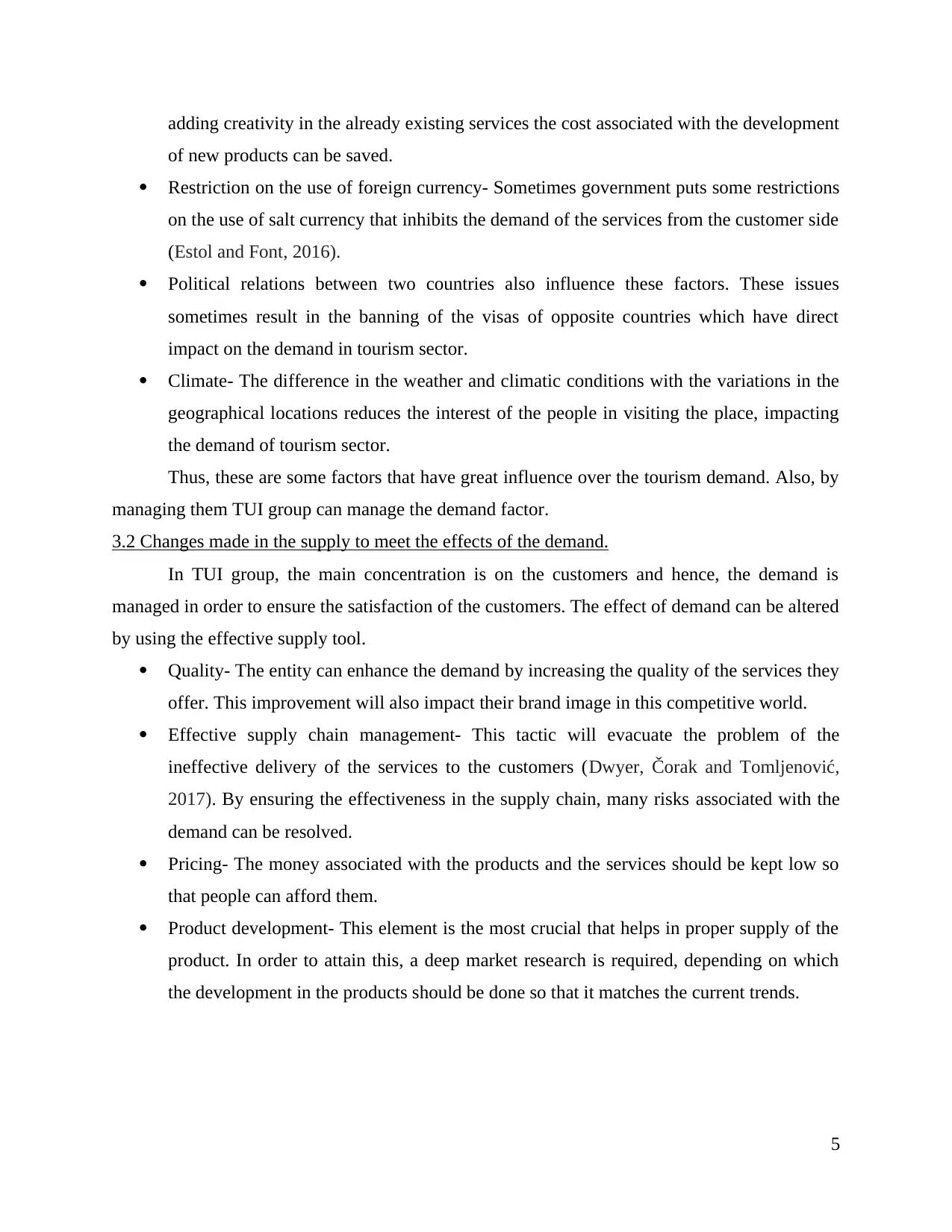
adding creativity in the already existing services the cost associated with the development
of new products can be saved.
Restriction on the use of foreign currency- Sometimes government puts some restrictions
on the use of salt currency that inhibits the demand of the services from the customer side
(Estol and Font, 2016).
Political relations between two countries also influence these factors. These issues
sometimes result in the banning of the visas of opposite countries which have direct
impact on the demand in tourism sector.
Climate- The difference in the weather and climatic conditions with the variations in the
geographical locations reduces the interest of the people in visiting the place, impacting
the demand of tourism sector.
Thus, these are some factors that have great influence over the tourism demand. Also, by
managing them TUI group can manage the demand factor.
3.2 Changes made in the supply to meet the effects of the demand.
In TUI group, the main concentration is on the customers and hence, the demand is
managed in order to ensure the satisfaction of the customers. The effect of demand can be altered
by using the effective supply tool.
Quality- The entity can enhance the demand by increasing the quality of the services they
offer. This improvement will also impact their brand image in this competitive world.
Effective supply chain management- This tactic will evacuate the problem of the
ineffective delivery of the services to the customers (Dwyer, Čorak and Tomljenović,
2017). By ensuring the effectiveness in the supply chain, many risks associated with the
demand can be resolved.
Pricing- The money associated with the products and the services should be kept low so
that people can afford them.
Product development- This element is the most crucial that helps in proper supply of the
product. In order to attain this, a deep market research is required, depending on which
the development in the products should be done so that it matches the current trends.
5
of new products can be saved.
Restriction on the use of foreign currency- Sometimes government puts some restrictions
on the use of salt currency that inhibits the demand of the services from the customer side
(Estol and Font, 2016).
Political relations between two countries also influence these factors. These issues
sometimes result in the banning of the visas of opposite countries which have direct
impact on the demand in tourism sector.
Climate- The difference in the weather and climatic conditions with the variations in the
geographical locations reduces the interest of the people in visiting the place, impacting
the demand of tourism sector.
Thus, these are some factors that have great influence over the tourism demand. Also, by
managing them TUI group can manage the demand factor.
3.2 Changes made in the supply to meet the effects of the demand.
In TUI group, the main concentration is on the customers and hence, the demand is
managed in order to ensure the satisfaction of the customers. The effect of demand can be altered
by using the effective supply tool.
Quality- The entity can enhance the demand by increasing the quality of the services they
offer. This improvement will also impact their brand image in this competitive world.
Effective supply chain management- This tactic will evacuate the problem of the
ineffective delivery of the services to the customers (Dwyer, Čorak and Tomljenović,
2017). By ensuring the effectiveness in the supply chain, many risks associated with the
demand can be resolved.
Pricing- The money associated with the products and the services should be kept low so
that people can afford them.
Product development- This element is the most crucial that helps in proper supply of the
product. In order to attain this, a deep market research is required, depending on which
the development in the products should be done so that it matches the current trends.
5
Paraphrase This Document
Need a fresh take? Get an instant paraphrase of this document with our AI Paraphraser
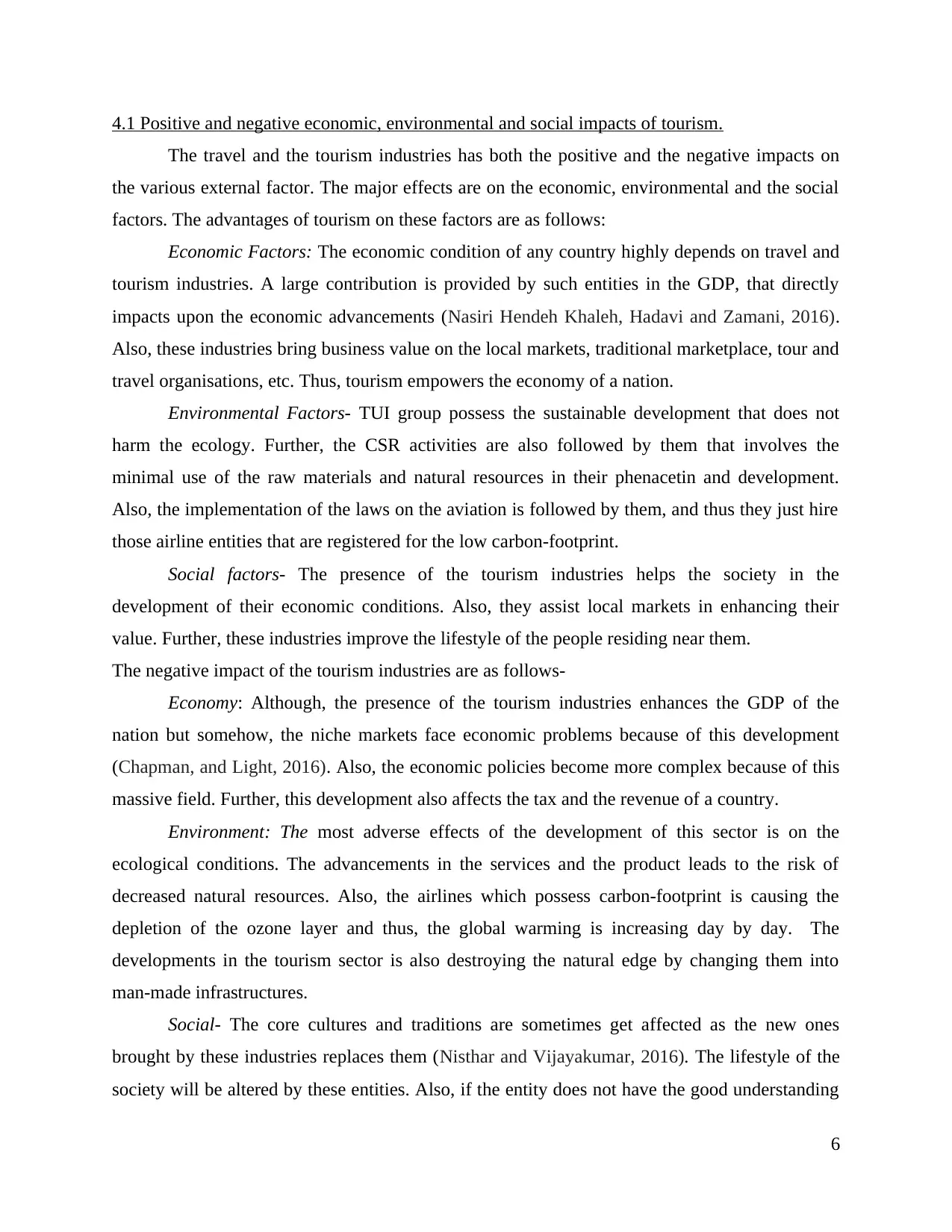
4.1 Positive and negative economic, environmental and social impacts of tourism.
The travel and the tourism industries has both the positive and the negative impacts on
the various external factor. The major effects are on the economic, environmental and the social
factors. The advantages of tourism on these factors are as follows:
Economic Factors: The economic condition of any country highly depends on travel and
tourism industries. A large contribution is provided by such entities in the GDP, that directly
impacts upon the economic advancements (Nasiri Hendeh Khaleh, Hadavi and Zamani, 2016).
Also, these industries bring business value on the local markets, traditional marketplace, tour and
travel organisations, etc. Thus, tourism empowers the economy of a nation.
Environmental Factors- TUI group possess the sustainable development that does not
harm the ecology. Further, the CSR activities are also followed by them that involves the
minimal use of the raw materials and natural resources in their phenacetin and development.
Also, the implementation of the laws on the aviation is followed by them, and thus they just hire
those airline entities that are registered for the low carbon-footprint.
Social factors- The presence of the tourism industries helps the society in the
development of their economic conditions. Also, they assist local markets in enhancing their
value. Further, these industries improve the lifestyle of the people residing near them.
The negative impact of the tourism industries are as follows-
Economy: Although, the presence of the tourism industries enhances the GDP of the
nation but somehow, the niche markets face economic problems because of this development
(Chapman, and Light, 2016). Also, the economic policies become more complex because of this
massive field. Further, this development also affects the tax and the revenue of a country.
Environment: The most adverse effects of the development of this sector is on the
ecological conditions. The advancements in the services and the product leads to the risk of
decreased natural resources. Also, the airlines which possess carbon-footprint is causing the
depletion of the ozone layer and thus, the global warming is increasing day by day. The
developments in the tourism sector is also destroying the natural edge by changing them into
man-made infrastructures.
Social- The core cultures and traditions are sometimes get affected as the new ones
brought by these industries replaces them (Nisthar and Vijayakumar, 2016). The lifestyle of the
society will be altered by these entities. Also, if the entity does not have the good understanding
6
The travel and the tourism industries has both the positive and the negative impacts on
the various external factor. The major effects are on the economic, environmental and the social
factors. The advantages of tourism on these factors are as follows:
Economic Factors: The economic condition of any country highly depends on travel and
tourism industries. A large contribution is provided by such entities in the GDP, that directly
impacts upon the economic advancements (Nasiri Hendeh Khaleh, Hadavi and Zamani, 2016).
Also, these industries bring business value on the local markets, traditional marketplace, tour and
travel organisations, etc. Thus, tourism empowers the economy of a nation.
Environmental Factors- TUI group possess the sustainable development that does not
harm the ecology. Further, the CSR activities are also followed by them that involves the
minimal use of the raw materials and natural resources in their phenacetin and development.
Also, the implementation of the laws on the aviation is followed by them, and thus they just hire
those airline entities that are registered for the low carbon-footprint.
Social factors- The presence of the tourism industries helps the society in the
development of their economic conditions. Also, they assist local markets in enhancing their
value. Further, these industries improve the lifestyle of the people residing near them.
The negative impact of the tourism industries are as follows-
Economy: Although, the presence of the tourism industries enhances the GDP of the
nation but somehow, the niche markets face economic problems because of this development
(Chapman, and Light, 2016). Also, the economic policies become more complex because of this
massive field. Further, this development also affects the tax and the revenue of a country.
Environment: The most adverse effects of the development of this sector is on the
ecological conditions. The advancements in the services and the product leads to the risk of
decreased natural resources. Also, the airlines which possess carbon-footprint is causing the
depletion of the ozone layer and thus, the global warming is increasing day by day. The
developments in the tourism sector is also destroying the natural edge by changing them into
man-made infrastructures.
Social- The core cultures and traditions are sometimes get affected as the new ones
brought by these industries replaces them (Nisthar and Vijayakumar, 2016). The lifestyle of the
society will be altered by these entities. Also, if the entity does not have the good understanding
6
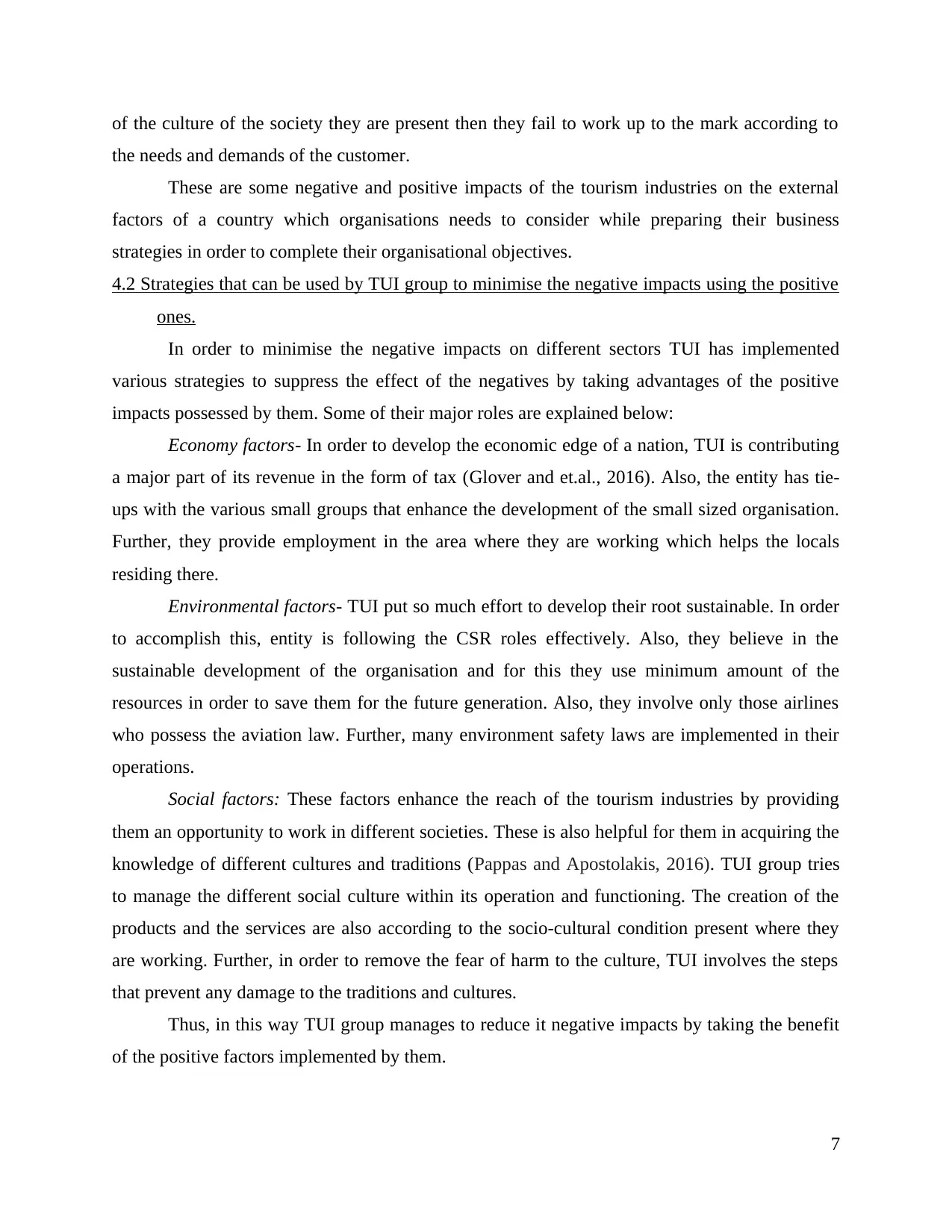
of the culture of the society they are present then they fail to work up to the mark according to
the needs and demands of the customer.
These are some negative and positive impacts of the tourism industries on the external
factors of a country which organisations needs to consider while preparing their business
strategies in order to complete their organisational objectives.
4.2 Strategies that can be used by TUI group to minimise the negative impacts using the positive
ones.
In order to minimise the negative impacts on different sectors TUI has implemented
various strategies to suppress the effect of the negatives by taking advantages of the positive
impacts possessed by them. Some of their major roles are explained below:
Economy factors- In order to develop the economic edge of a nation, TUI is contributing
a major part of its revenue in the form of tax (Glover and et.al., 2016). Also, the entity has tie-
ups with the various small groups that enhance the development of the small sized organisation.
Further, they provide employment in the area where they are working which helps the locals
residing there.
Environmental factors- TUI put so much effort to develop their root sustainable. In order
to accomplish this, entity is following the CSR roles effectively. Also, they believe in the
sustainable development of the organisation and for this they use minimum amount of the
resources in order to save them for the future generation. Also, they involve only those airlines
who possess the aviation law. Further, many environment safety laws are implemented in their
operations.
Social factors: These factors enhance the reach of the tourism industries by providing
them an opportunity to work in different societies. These is also helpful for them in acquiring the
knowledge of different cultures and traditions (Pappas and Apostolakis, 2016). TUI group tries
to manage the different social culture within its operation and functioning. The creation of the
products and the services are also according to the socio-cultural condition present where they
are working. Further, in order to remove the fear of harm to the culture, TUI involves the steps
that prevent any damage to the traditions and cultures.
Thus, in this way TUI group manages to reduce it negative impacts by taking the benefit
of the positive factors implemented by them.
7
the needs and demands of the customer.
These are some negative and positive impacts of the tourism industries on the external
factors of a country which organisations needs to consider while preparing their business
strategies in order to complete their organisational objectives.
4.2 Strategies that can be used by TUI group to minimise the negative impacts using the positive
ones.
In order to minimise the negative impacts on different sectors TUI has implemented
various strategies to suppress the effect of the negatives by taking advantages of the positive
impacts possessed by them. Some of their major roles are explained below:
Economy factors- In order to develop the economic edge of a nation, TUI is contributing
a major part of its revenue in the form of tax (Glover and et.al., 2016). Also, the entity has tie-
ups with the various small groups that enhance the development of the small sized organisation.
Further, they provide employment in the area where they are working which helps the locals
residing there.
Environmental factors- TUI put so much effort to develop their root sustainable. In order
to accomplish this, entity is following the CSR roles effectively. Also, they believe in the
sustainable development of the organisation and for this they use minimum amount of the
resources in order to save them for the future generation. Also, they involve only those airlines
who possess the aviation law. Further, many environment safety laws are implemented in their
operations.
Social factors: These factors enhance the reach of the tourism industries by providing
them an opportunity to work in different societies. These is also helpful for them in acquiring the
knowledge of different cultures and traditions (Pappas and Apostolakis, 2016). TUI group tries
to manage the different social culture within its operation and functioning. The creation of the
products and the services are also according to the socio-cultural condition present where they
are working. Further, in order to remove the fear of harm to the culture, TUI involves the steps
that prevent any damage to the traditions and cultures.
Thus, in this way TUI group manages to reduce it negative impacts by taking the benefit
of the positive factors implemented by them.
7
⊘ This is a preview!⊘
Do you want full access?
Subscribe today to unlock all pages.

Trusted by 1+ million students worldwide
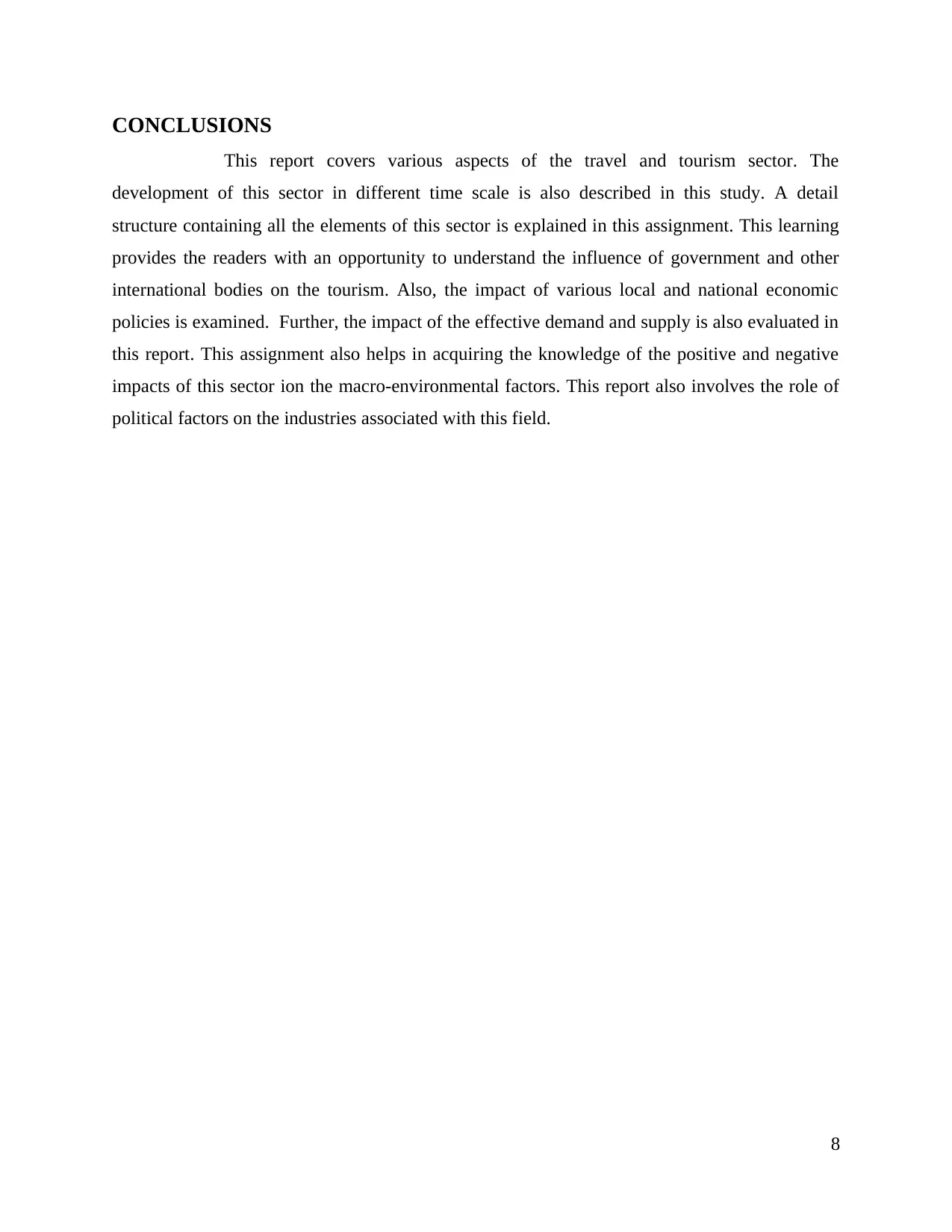
CONCLUSIONS
This report covers various aspects of the travel and tourism sector. The
development of this sector in different time scale is also described in this study. A detail
structure containing all the elements of this sector is explained in this assignment. This learning
provides the readers with an opportunity to understand the influence of government and other
international bodies on the tourism. Also, the impact of various local and national economic
policies is examined. Further, the impact of the effective demand and supply is also evaluated in
this report. This assignment also helps in acquiring the knowledge of the positive and negative
impacts of this sector ion the macro-environmental factors. This report also involves the role of
political factors on the industries associated with this field.
8
This report covers various aspects of the travel and tourism sector. The
development of this sector in different time scale is also described in this study. A detail
structure containing all the elements of this sector is explained in this assignment. This learning
provides the readers with an opportunity to understand the influence of government and other
international bodies on the tourism. Also, the impact of various local and national economic
policies is examined. Further, the impact of the effective demand and supply is also evaluated in
this report. This assignment also helps in acquiring the knowledge of the positive and negative
impacts of this sector ion the macro-environmental factors. This report also involves the role of
political factors on the industries associated with this field.
8
Paraphrase This Document
Need a fresh take? Get an instant paraphrase of this document with our AI Paraphraser
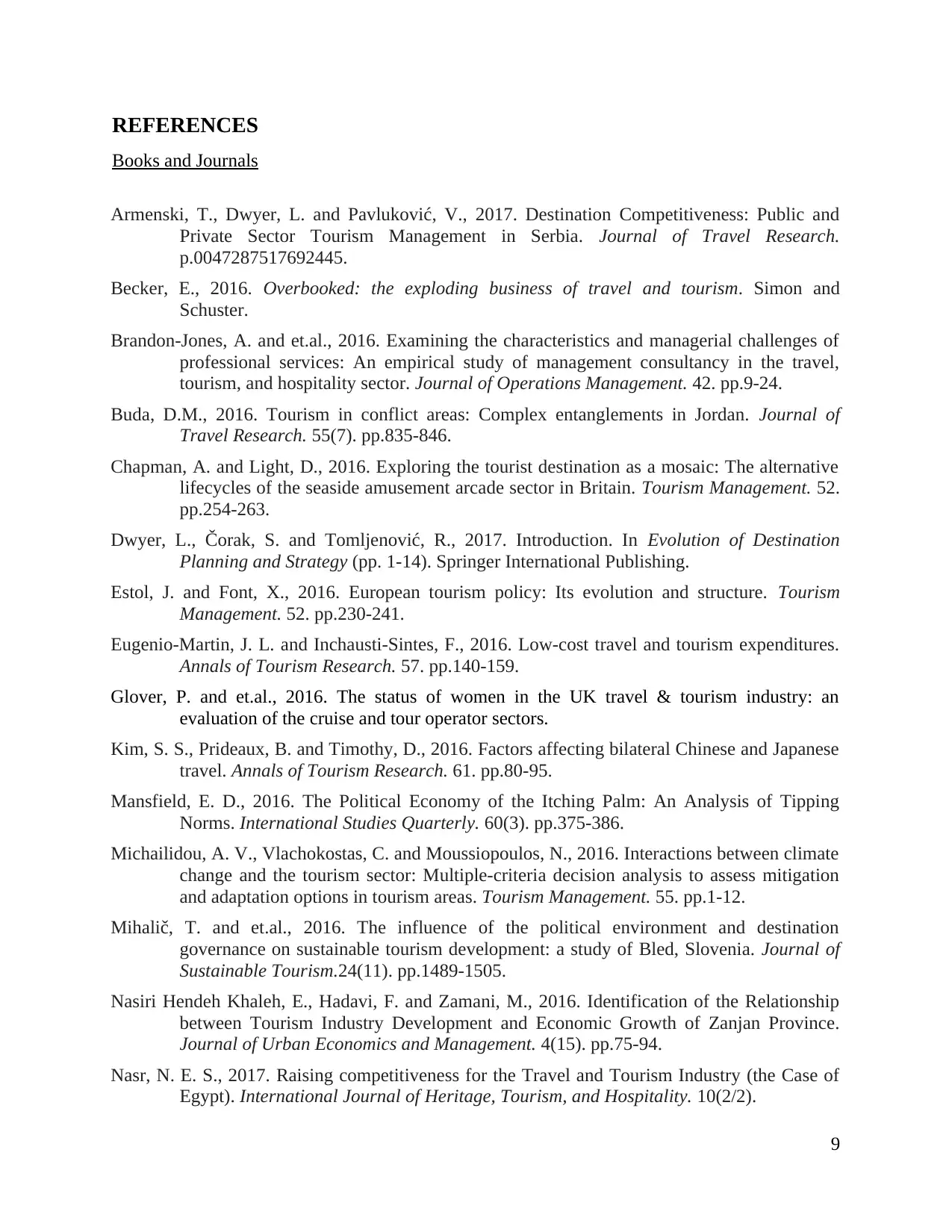
REFERENCES
Books and Journals
Armenski, T., Dwyer, L. and Pavluković, V., 2017. Destination Competitiveness: Public and
Private Sector Tourism Management in Serbia. Journal of Travel Research.
p.0047287517692445.
Becker, E., 2016. Overbooked: the exploding business of travel and tourism. Simon and
Schuster.
Brandon-Jones, A. and et.al., 2016. Examining the characteristics and managerial challenges of
professional services: An empirical study of management consultancy in the travel,
tourism, and hospitality sector. Journal of Operations Management. 42. pp.9-24.
Buda, D.M., 2016. Tourism in conflict areas: Complex entanglements in Jordan. Journal of
Travel Research. 55(7). pp.835-846.
Chapman, A. and Light, D., 2016. Exploring the tourist destination as a mosaic: The alternative
lifecycles of the seaside amusement arcade sector in Britain. Tourism Management. 52.
pp.254-263.
Dwyer, L., Čorak, S. and Tomljenović, R., 2017. Introduction. In Evolution of Destination
Planning and Strategy (pp. 1-14). Springer International Publishing.
Estol, J. and Font, X., 2016. European tourism policy: Its evolution and structure. Tourism
Management. 52. pp.230-241.
Eugenio-Martin, J. L. and Inchausti-Sintes, F., 2016. Low-cost travel and tourism expenditures.
Annals of Tourism Research. 57. pp.140-159.
Glover, P. and et.al., 2016. The status of women in the UK travel & tourism industry: an
evaluation of the cruise and tour operator sectors.
Kim, S. S., Prideaux, B. and Timothy, D., 2016. Factors affecting bilateral Chinese and Japanese
travel. Annals of Tourism Research. 61. pp.80-95.
Mansfield, E. D., 2016. The Political Economy of the Itching Palm: An Analysis of Tipping
Norms. International Studies Quarterly. 60(3). pp.375-386.
Michailidou, A. V., Vlachokostas, C. and Moussiopoulos, Ν., 2016. Interactions between climate
change and the tourism sector: Multiple-criteria decision analysis to assess mitigation
and adaptation options in tourism areas. Tourism Management. 55. pp.1-12.
Mihalič, T. and et.al., 2016. The influence of the political environment and destination
governance on sustainable tourism development: a study of Bled, Slovenia. Journal of
Sustainable Tourism.24(11). pp.1489-1505.
Nasiri Hendeh Khaleh, E., Hadavi, F. and Zamani, M., 2016. Identification of the Relationship
between Tourism Industry Development and Economic Growth of Zanjan Province.
Journal of Urban Economics and Management. 4(15). pp.75-94.
Nasr, N. E. S., 2017. Raising competitiveness for the Travel and Tourism Industry (the Case of
Egypt). International Journal of Heritage, Tourism, and Hospitality. 10(2/2).
9
Books and Journals
Armenski, T., Dwyer, L. and Pavluković, V., 2017. Destination Competitiveness: Public and
Private Sector Tourism Management in Serbia. Journal of Travel Research.
p.0047287517692445.
Becker, E., 2016. Overbooked: the exploding business of travel and tourism. Simon and
Schuster.
Brandon-Jones, A. and et.al., 2016. Examining the characteristics and managerial challenges of
professional services: An empirical study of management consultancy in the travel,
tourism, and hospitality sector. Journal of Operations Management. 42. pp.9-24.
Buda, D.M., 2016. Tourism in conflict areas: Complex entanglements in Jordan. Journal of
Travel Research. 55(7). pp.835-846.
Chapman, A. and Light, D., 2016. Exploring the tourist destination as a mosaic: The alternative
lifecycles of the seaside amusement arcade sector in Britain. Tourism Management. 52.
pp.254-263.
Dwyer, L., Čorak, S. and Tomljenović, R., 2017. Introduction. In Evolution of Destination
Planning and Strategy (pp. 1-14). Springer International Publishing.
Estol, J. and Font, X., 2016. European tourism policy: Its evolution and structure. Tourism
Management. 52. pp.230-241.
Eugenio-Martin, J. L. and Inchausti-Sintes, F., 2016. Low-cost travel and tourism expenditures.
Annals of Tourism Research. 57. pp.140-159.
Glover, P. and et.al., 2016. The status of women in the UK travel & tourism industry: an
evaluation of the cruise and tour operator sectors.
Kim, S. S., Prideaux, B. and Timothy, D., 2016. Factors affecting bilateral Chinese and Japanese
travel. Annals of Tourism Research. 61. pp.80-95.
Mansfield, E. D., 2016. The Political Economy of the Itching Palm: An Analysis of Tipping
Norms. International Studies Quarterly. 60(3). pp.375-386.
Michailidou, A. V., Vlachokostas, C. and Moussiopoulos, Ν., 2016. Interactions between climate
change and the tourism sector: Multiple-criteria decision analysis to assess mitigation
and adaptation options in tourism areas. Tourism Management. 55. pp.1-12.
Mihalič, T. and et.al., 2016. The influence of the political environment and destination
governance on sustainable tourism development: a study of Bled, Slovenia. Journal of
Sustainable Tourism.24(11). pp.1489-1505.
Nasiri Hendeh Khaleh, E., Hadavi, F. and Zamani, M., 2016. Identification of the Relationship
between Tourism Industry Development and Economic Growth of Zanjan Province.
Journal of Urban Economics and Management. 4(15). pp.75-94.
Nasr, N. E. S., 2017. Raising competitiveness for the Travel and Tourism Industry (the Case of
Egypt). International Journal of Heritage, Tourism, and Hospitality. 10(2/2).
9
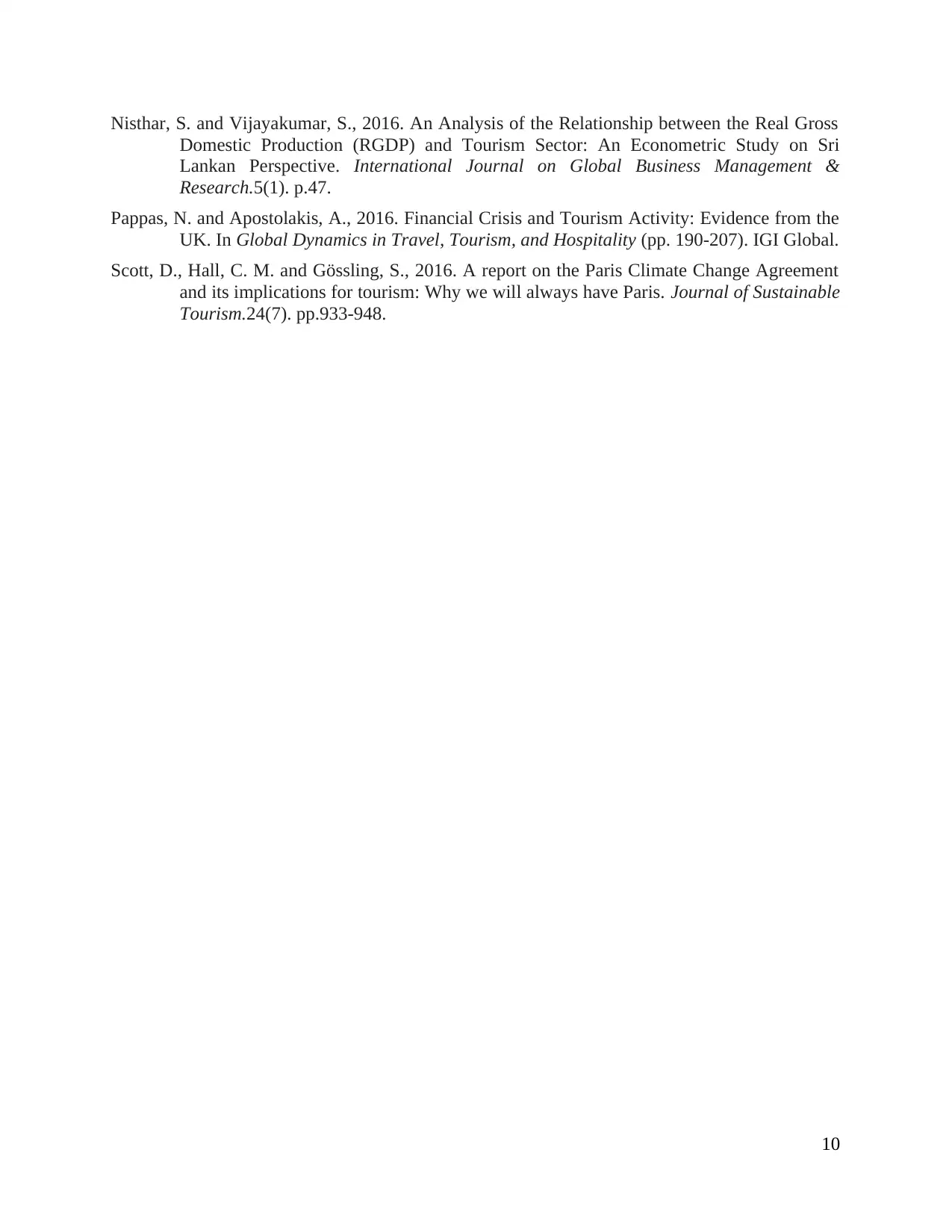
Nisthar, S. and Vijayakumar, S., 2016. An Analysis of the Relationship between the Real Gross
Domestic Production (RGDP) and Tourism Sector: An Econometric Study on Sri
Lankan Perspective. International Journal on Global Business Management &
Research.5(1). p.47.
Pappas, N. and Apostolakis, A., 2016. Financial Crisis and Tourism Activity: Evidence from the
UK. In Global Dynamics in Travel, Tourism, and Hospitality (pp. 190-207). IGI Global.
Scott, D., Hall, C. M. and Gössling, S., 2016. A report on the Paris Climate Change Agreement
and its implications for tourism: Why we will always have Paris. Journal of Sustainable
Tourism.24(7). pp.933-948.
10
Domestic Production (RGDP) and Tourism Sector: An Econometric Study on Sri
Lankan Perspective. International Journal on Global Business Management &
Research.5(1). p.47.
Pappas, N. and Apostolakis, A., 2016. Financial Crisis and Tourism Activity: Evidence from the
UK. In Global Dynamics in Travel, Tourism, and Hospitality (pp. 190-207). IGI Global.
Scott, D., Hall, C. M. and Gössling, S., 2016. A report on the Paris Climate Change Agreement
and its implications for tourism: Why we will always have Paris. Journal of Sustainable
Tourism.24(7). pp.933-948.
10
⊘ This is a preview!⊘
Do you want full access?
Subscribe today to unlock all pages.

Trusted by 1+ million students worldwide
1 out of 12
Related Documents
Your All-in-One AI-Powered Toolkit for Academic Success.
+13062052269
info@desklib.com
Available 24*7 on WhatsApp / Email
![[object Object]](/_next/static/media/star-bottom.7253800d.svg)
Unlock your academic potential
Copyright © 2020–2025 A2Z Services. All Rights Reserved. Developed and managed by ZUCOL.





